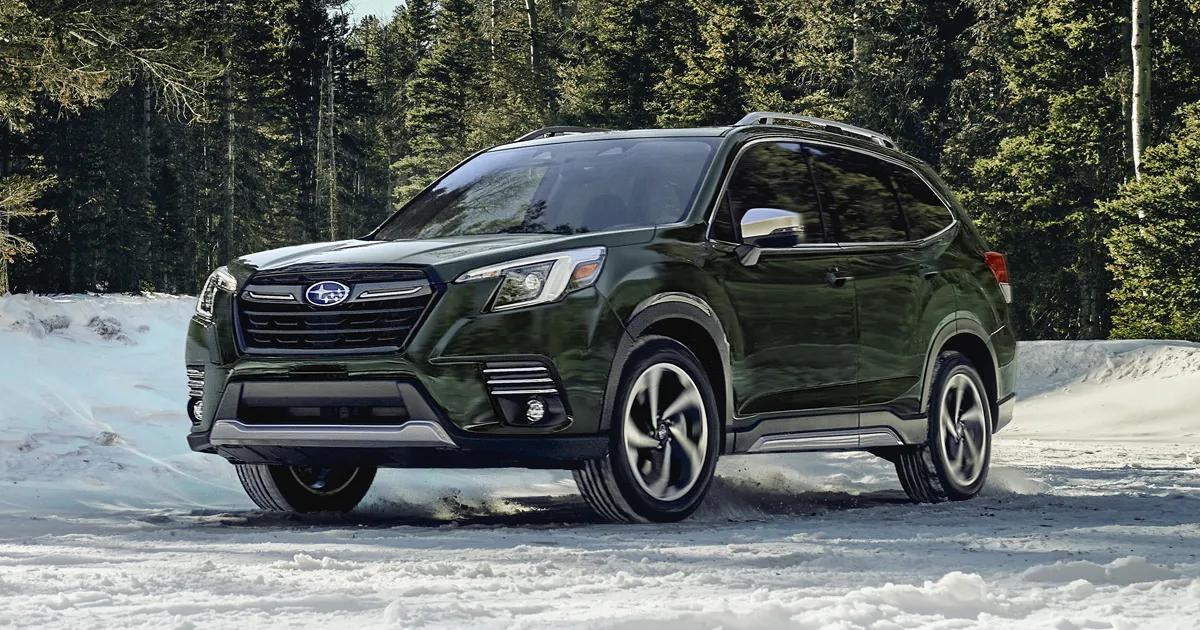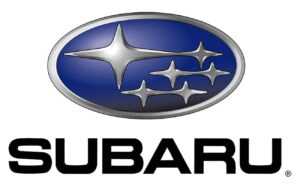Subaru Forester 2023 Seatbelt pre-tensioners and Child restraint
The child restraint and seatbelt pretensioners on the 2023 Subaru Forester are essential components of passenger safety. In the case of a collision, seatbelt pretensioners automatically tighten the belts, decreasing slack and guaranteeing that people are safely fastened. In order to guarantee that young passengers are securely and appropriately secured when riding in the Forester, the child restraint system also offers a safe and designated anchoring position for child safety seats. These features, which provide families and passengers in the 2023 Forester with peace of mind, demonstrate Subaru’s dedication to safety.
2023 Subaru Forester Specs, Price, Features, Mileage (Brochure)
Seatbelt pretensioners
The following seatbelts have a seatbelt pretensioner.
- Driver’s seatbelt
- Front passenger’s seatbelt
- Rear passenger’s seatbelt (window-side)
The seatbelt pretensioners are designed to be activated in the event of an accident involving a moderate to severe frontal and side collision and rollover accident.
WARNING
- To obtain maximum protection, the occupants should sit in an upright position with their seatbelts properly fastened.
- Do not modify, remove or strike the seatbelt retractor assemblies equipped with seatbelt pretensioners or the surrounding area. This could result in accidental activation of the seatbelt pretensioners or could make the system inoperative, possibly resulting in serious injury. Seatbelt pretensioners have no user-serviceable parts. For required servicing of seatbelt retractors equipped with seatbelt pretensioners, consult your SUBARU dealer.
- When discarding seatbelt retractor assemblies equipped with seatbelt pretensioners or scrapping the entire vehicle due to collision damage or for other reasons, consult your SUBARU dealer.
NOTE
- Seatbelt pretensioners are not designed to activate in minor impacts or in rear impacts.
- Pretensioners are designed to function on a one-time-only basis. In the event that pretension is activated, both the driver’s and front passenger’s seatbelt retractor assemblies should be replaced only by an authorized SUBARU dealer. When replacing seatbelt retractor assemblies, use only genuine SUBARU parts.
- If a seatbelt that has a seatbelt pretensioner does not retract or cannot be pulled out due to a malfunction or activation of the pretensioner, contact your SUBARU dealer as soon as possible.
- If the seatbelt retractor assembly or surrounding area has been damaged, contact your SUBARU dealer as soon as possible.
- When you sell your vehicle, we urge you to inform the buyer that the vehicle is equipped with seatbelt pretensioners. Also, notify the buyer of the contents in this section.
Driver’s seatbelt
The driver’s seatbelt has a shoulder belt pretensioner.
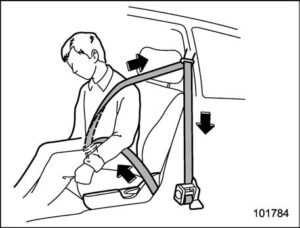
Front seatbelt pretensioner
The pre-tensioner sensor also serves as follows.
- SRS frontal airbag sensor
- Side impact sensor
- Front door impact sensor
- Rollover sensor
If the sensor detects a certain predetermined amount of force during frontal or side collisions or rollover accidents, any seatbelt that has a seatbelt pre-tensioner is quickly drawn back in by the retractor to take up the slack so that the belt more effectively restrains the seat occupant. The driver’s seatbelt pre-tensioner includes a tension-reducing device that limits the peak forces exerted by the seatbelt on the occupant in the event of a collision. When a seatbelt pre-tensioner is activated, an operating noise will be heard and a small amount of smoke will be released. These occurrences are normal and not harmful. This smoke does not indicate a fire in the vehicle. Once the seatbelt pre-tensioner has been activated, the seatbelt retractor remains locked. Consequently, the seatbelt cannot be pulled out and retracted and therefore must be replaced. In cases of rollover accidents, frontal collisions or side collisions, the following components will operate simultaneously
Front passenger’s seatbelt
The front passenger’s seatbelt has a shoulder belt and a lap belt pretensioner.
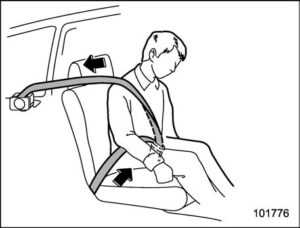
- Seatbelt retractor assembly (shoulder belt pre-tensioner and adaptive force limiter)
- Lap belt pretensioner
On the front passenger’s side, the shoulder belt pre-tensioner is supplemented by a lap belt pre-tensioner, which is an SRS airbags/Seatbelt pretensioner located at the base of the center pillar. Like the shoulder belt pretensioner, the lap belt pretensioner instantaneously pulls in the belt to eliminate slack if a certain level of frontal collision force is detected. As a result, the seatbelt restrains the front seat occupant more effectively. The front passenger’s seatbelt pre-tensioner includes a tension-reducing device that limits the peak forces exerted by the seatbelt on the occupant in the event of a collision. The adaptive force limiter will select a reducing load to the suit body size of the occupant as detected by the occupant detection sensor. When a seatbelt pretensioner is activated, an operating noise will be heard and a small amount of smoke will be released. These occurrences are normal and not harmful. This smoke does not indicate a fire in the vehicle. Once the seatbelt pre-tensioner has been activated, the seatbelt retractor remains locked. Consequently, the seatbelt can not be pulled out and retracted and therefore must be replaced.
Seatbelt with shoulder belt and lap belt pretensioners
NOTE
This section is applicable to the front seatbelt.

- Seatbelt retractor assembly (shoulder belt pre-tensioner and adaptive force limiter)
- Lap belt pretensioner
The shoulder belt pre-tensioner is supplemented by a lap belt pre-tensioner, which is located at the base of the center pillar. Like the shoulder belt pre-tensioner, the lap belt pretensioner instantaneously pulls in the belt to eliminate slack if a certain level of frontal collision force is detected. As a result, the seatbelt restrains the front seat occupant more effectively. The front seatbelt pre-tensioner includes a tension-reducing device that limits the peak forces exerted by the seatbelt on the occupant in the event of a collision. The adaptive force limiter will select a reducing load to the suit body size of the occupant as detected by the occupant detection system sensors. When a seatbelt pre-tensioner is activated, an operating noise will be heard and a small amount of smoke will be released. These occurrences are normal and not harmful. This smoke does not indicate a fire in the vehicle. Once the seatbelt pre-tensioner has been activated, the seatbelt pre-tensioner remains locked. Consequently, the seatbelt cannot be pulled out and retracted and therefore must be replaced.
System monitors
A diagnostic system continually monitors the readiness of the seatbelt pre-tensioner with the ignition switch in the “ON” position. The seatbelt pre-tensioners share the control module with the SRS airbag system. Therefore, if any malfunction occurs in a seatbelt pretensioner, the SRS airbag system warning light will illuminate.
System Servicing
WARNING
- When discarding a seatbelt retractor assembly or scrapping the entire vehicle damaged by a collision, consult your SUBARU dealer.
- Tampering with or disconnecting the system’s wiring could result in accidental activation of the seatbelt pre-tensioner and/or SRS airbag or could make the system inoperative, which may result in serious injury. Do not use electrical test equipment on any circuit related to the seatbelt pre-tensioner and SRS airbag systems. For required servicing of the seatbelt pre-tensioner, consult your nearest SUBARU dealer.
CAUTION
If you need service or repair in those areas or near the front seatbelt retractors, have the work performed by your authorized SUBARU dealer.
NOTE
If the front or side part of the vehicle is damaged in an accident to the extent that the seatbelt pre-tensioner does not operate, contact your SUBARU dealer as soon as possible. & Precautions against vehicle modification. Always consult your SUBARU dealer if you want to install any accessory parts to your vehicle.
CAUTION
Do not perform any of the following modifications. Such modifications can interfere with the proper operation of the seatbelt pre-tensioners.
- Attachment of any equipment (bush bar, winches, snow plow, skid plate, etc.) other than genuine SUBARU accessory parts to the front end.
- Modification of the suspension system or front-end structure.
- Installation of a tire of different sizes and construction from the tires specified on the vehicle placard attached to the driver’s door pillar or specified for individual vehicle models in this Owner’s Manual.
Rear Seat Reminder
This function prompts the driver to confirm the presence of passengers and cargo in the rear. This function will be activated when the rear doors are opened and closed. It alerts the driver by warning messages on the combination meter display (color LCD) and beeps when the ignition switch is turned from the “ON” position to the “OFF” position.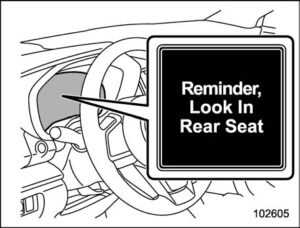
NOTE
- This function does not directly detect passengers and cargo in the rear seat.
- This function detects the opening and closing of the rear doors. In this situation, there is the possibility that the following phenomenon may occur.
- It may alert the driver even if there are no passengers or cargo in the rear seat.
- It may not alert the driver even if there are passengers and cargo in the rear seat.
- This function can be turned ON/OFF using the meter customizing function.
- The ON/OFF setting will not be changed even if the ignition switch is turned to the “OFF” position.
- The ON/OFF setting will be returned to the default setting if the battery is removed.
Child restraint systems
Safety precautions

Infants and small children should always be placed in an infant or child restraint system in the rear seat while riding in the vehicle. You should use an infant or child restraint system that meets Federal Motor Vehicle Safety Standards or Canada Motor Vehicle Safety Standards, is compatible with your vehicle and is appropriate for the child’s age and size. All child restraint systems are designed to be secured in vehicle seats by lap belts or the lap belt portion of a lap/shoulder belt (except those described in “Installation of child restraint systems by use of lower and tether anchorages (LATCH)” P71). Children could be endangered in an accident if their child restraint systems are not properly secured in the vehicle. When installing the child restraint system, carefully follow the manufacturer’s instructions. According to accident statistics, children are safer when properly restrained in the rear seating positions than in the front seating positions. All U.S. states and Canadian provinces require that infants and small children be restrained in an approved child restraint system at all times while the vehicle is moving.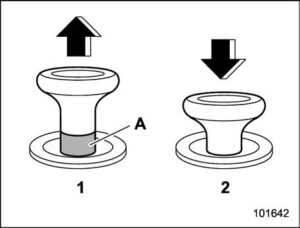
Lock release knob
- Unlocked
- Locked
An Unlocking marker in red
WARNING
- Before installing a child restraint system, be sure to confirm that the seatback is securely locked into place. Otherwise, in an accident, serious injury or death could result.
- Do not leave children in the car unattended. High interior temperatures may cause heat stroke and dehydration that result in serious injury or death.
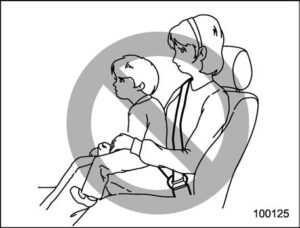
WARNING
Never let a passenger hold a child on his or her lap or in his or her arms while the vehicle is moving. The passenger cannot protect the child (or infant) from injury in a collision, because the child will be caught between the passenger and objects inside the vehicle. Additionally, holding a child in your lap or arms in the front seat exposes that child to another serious danger. Since the SRS airbag deploys with considerable speed and force, the child could be injured or even killed.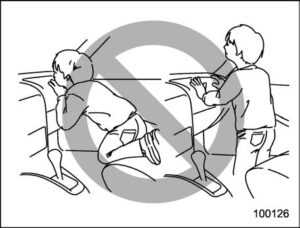
WARNING
Children should be properly restrained at all times. Never allow a child to stand up, or to kneel on any seat. Unrestrained children will be thrown forward during a sudden stop or in an accident and can be injured seriously. Additionally, children standing up or kneeling on or in front of the front seat are exposed to another serious danger. Since the SRS airbag deploys with considerable speed and force, the child could be injured or even killed.
Safety tips for installing child restraint systems
WARNING
- Child restraint systems and seatbelts can become hot in a vehicle that has been closed up in sunny weather; they could burn a small child. Check the child restraint system before you place a child in it.
- Do not use a seatbelt extender. If a seatbelt extender is used when installing a child restraint system, the seatbelt will not securely hold the child restraint system. Use of a seatbelt extender could cause death or serious injury to children or other passengers in sudden braking, swerving, or accidents.
- Attach the child restraint system to the anchors properly. When using the LATCH anchors, be sure that there are no foreign objects around the anchors. Make sure the child restraint system is securely attached. Otherwise, it may cause death or serious injury to children or other passengers in sudden braking, swerving, or accidents.
- Do not leave an unsecured child restraint system in your vehicle. Unsecured child restraint systems can be thrown around inside of the vehicle in a sudden stop, turn or accident; they can strike and injure vehicle occupants as well as result in serious injuries or death to the child.
CAUTION
When you install a child restraint system, follow the manufacturer’s instructions supplied with it. After installing the child restraint system, check to ensure that it is held securely in position. If it is not held tight and secure, the danger of your child suffering personal injury in the event of an accident may be increased.
Where to place a child restraint system
The following descriptions are SUBARU’s recommendations on where to place a child restraint system in your vehicle.
WARNING
- Several types of child restraint systems may conceal the buckle of the neighboring seat. If the occupant of the neighboring seat cannot correctly fasten the seatbelt, that person must move to a different seat. If the seatbelt cannot be correctly fastened, there is the risk of serious injury or death in the event of sudden braking or a collision.
- If the child restraint system cannot be correctly installed because it contacts the driver’s seat, moves the child restraint system to a different seat. If it cannot be installed in a different seat (other than the driver’s seat), adjust the front seat so that contact does not occur.
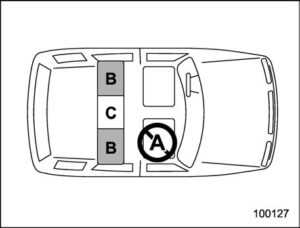
A: Front passenger’s seat
You should not install a child restraint system (including a booster seat) due to the hazard to children posed by the passenger’s airbag.
B: Rear seat, window-side seating positions Recommended positions for all types of child restraint systems.
In these positions, the following equipment is provided for installing a child restraint system.
- Automatic Locking Retractor/Emergency Locking Retractor (ALR/ELR) seatbelts
- Lower anchorages (bars)
- Upper anchorages (tether anchorages) Some types of child restraint systems might not be able to be secured firmly due to the projection of the seat cushion.
In this seating position, you should use only a child restraint system that has a bottom base that fits snugly against the contours of the seat cushion and can be securely retained using the seatbelt.
C: Rear seat, center seating position In this position, the following equipment is provided for installing a child restraint system.
- ALR/ELR seatbelts
- Lower anchorages (bars)
- Top tether anchorages
Some types of child restraint systems might not be able to be secured firmly due to the projection of the seat cushion. In this seating position, you should use only a child restraint system that has a bottom base that fits snugly against the contours of the seat cushion and can be securely retained using the seatbelt. The rear center seat includes lower anchorages and the lower anchorages on the center side of the rear right seat can be used to install a child restraint system. When a child restraint system is installed in the rear center seat using the lower anchorages, do not sit in the rear seat. If a child restraint system is not correctly fixed in place (for example, if a child restraint system can be moved more than 1 inch (2.5 cm) from side to side), the child restraint system should be moved to a window seat position of the rear seat.
WARNING
- Even with advanced airbags, children can be seriously injured by the airbag. Seat children in the rear seat properly restrained at all times. The SRS airbag deploys with considerable speed and force and can injure or even kill children, especially if they are not restrained or improperly restrained. Because children are lighter and weaker than adults, their risk of being injured from deployment is greater.
- For that reason, be sure to secure ALL types of child restraint systems (including forward-facing child restraint systems) in the REAR seats at all times. You should choose a restraint system that is appropriate for the child’s age, height and weight. According to accident statistics, children are safer when properly restrained in the rear seating positions than in the front seating positions.
- Do not use lower anchorages (bars) for a seat in the center seating position unless a child restraint system manufacturer’s instructions permit and specify using anchors spaced as far apart as those in this vehicle.
- Do not connect two or lower hooks onto the same anchorage (bar).
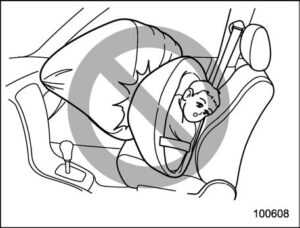
WARNING
- SINCE YOUR VEHICLE IS EQUIPPED WITH A PASSEN-GER’S SRS AIRBAG, NEVER IN-STALL A CHILD RESTRAINT SYSTEM IN THE FRONT PASSENGER’S SEAT. DOING SO RISKS SERIOUS INJURY OR DEATH TO THE CHILD BY PLACING THE CHILD’S HEAD TOO CLOSE TO THE SRS AIRBAG.
- Do not allow children to lean their heads or any other parts of their bodies against the door or the area of the seat, front and rear pillars or roof side rails. The SRS side airbags and SRS curtain airbags deploy even if children are seated in the child restraint system, and the impact could cause death or serious injury to the child.
- To secure the child restraint system, be sure to comply with all installation instructions provided by the child restraint system manufacturer. Not doing so could result in death or serious injury to children in a sudden stop or accident.
Choosing a child restraint system
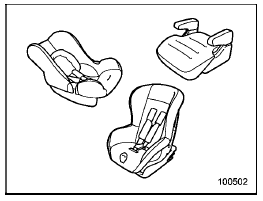
Choose a child restraint system that is appropriate for the child’s age and size (weight and height) in order to provide the child with proper protection. The child restraint system should meet all applicable requirements of Federal Motor Vehicle Safety Standards for the United States or of Canada Motor Vehicle Safety Standards for Canada. It can be identified by looking for the label on the child restraint system or the manufacturer’s statement of compliance in the document attached to the system. Also it is important for you to make sure that the child restraint system is compatible with the vehicle in which it will be used.
NOTE
Some sizes of child restraint systems may not fit the vehicle seat. Before purchasing a child restraint system, check whether it fits on the vehicle seat.
Installing child restraint systems with ALR/ELR seatbelts
CAUTION
- When you install a child restraint system, follow the manufacturer’s instructions supplied with it. After installing the child restraint system, check to ensure that it is held securely in position. If it is not held tight and secure, the danger of your child suffering personal injury in the event of an accident may be increased.
- When installing a child restraint system in the rear center seating position, set both seatbacks to the original position. Otherwise, the child restraint system cannot be securely restrained, which may result in death or serious injuries in the event of sudden stop, sudden steering maneuver or an accident.
Installing a rearward-facing child restraint system
WARNING
- NEVER INSTALL A CHILD RESTRAINT SYSTEM IN THE FRONT PASSENGER’S SEAT. DOING SO RISKS SERIOUS INJURY OR DEATH TO THE CHILD BY PLA-CING THE CHILD’S HEAD TOO CLOSE TO THE SRS AIRBAG.
- Before installing a child restraint system, be sure to confirm that the seatback is securely locked into place. Otherwise, in an accident, serious injury or death could result.
- Place the child restraint system in the rear seating position.
WARNING
When you intend to install a child restraint system in the rear center seating position, if the child restraint system does not fit snugly against the contours of the rear center seat cushion, install the child restraint system in the window-side seating position to be safe.
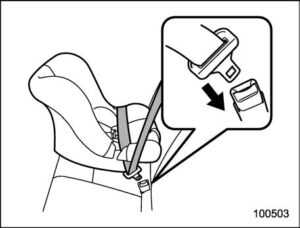
- Run the lap and shoulder belt through or around the child restraint system following the instructions provided by its manufacturer.
- Insert the tongue plate into the buckle until you hear a click.

- Take up the slack in the lap belt.
- If using the seatbelt in the ALR mode is recommended by the manufacturer’s instructions supplied with the child restraint system, perform the following procedure.
- Pull out the seatbelt fully from the retractor to change the retractor over from the Emergency Locking Retractor (ELR) to the Automatic Locking Retractor (ALR) mode.
- Allow the belt to rewind into the retractor. As the belt is rewinding, clicks will be heard which indicate the retractor functions as ALR.
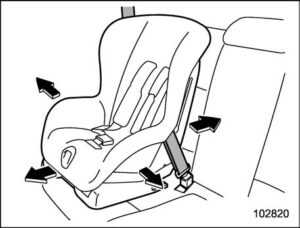
- Before having a child sit in the child restraint system, try to move it back and forth and right and left to check if it is firmly secured. Sometimes a child restraint system can be more firmly secured by pushing it down into the seat cushion and then tightening the seatbelt. It should not be possible to move the child restraint system more than 1 in (2.5 cm) in any direction along the seatbelt path.
- If the seatbelt has been set to the ALR mode in step 5, pull at the shoulder portion of the belt to confirm that it cannot be pulled out (ALR properly functioning).

- To remove the child restraint system, press the release button on the seat-belt buckle and allow the belt to retract completely. The belt will return to the ELR mode.
NOTE
When the child restraint system is no longer in use, remove it and restore the ELR function of the retractor. That function is restored by allowing the seatbelt to retract fully.
Installing a forward-facing child restraint system
WARNING
- NEVER INSTALL A CHILD RESTRAINT SYSTEM IN THE FRONT PASSENGER’S SEAT. DOING SO RISKS SERIOUS INJURY OR DEATH TO THE CHILD BY PLACING THE CHILD’S HEAD TOO CLOSE TO THE SRS AIRBAG.
- Before installing a child restraint system, be sure to confirm that the seatback is securely locked into place. Otherwise, in an accident, serious injury or death could result.
- Place the child restraint system in the rear seating position.
- For models with rear seat reclining mechanisms, if there is a gap between the child restraint system and the seatback, adjust the seatback angle until good contact is achieved.
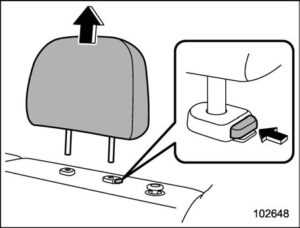
- Remove the head restraint of the rear seating position where the child restraint system is to be installed. For details, refer to “Head restraints”
P43.
CAUTION
Store the head restraint in the cargo area. Do not place the head restraint in the passenger compartment to prevent it from being thrown around in the passenger compartment in a sudden stop or a sharp turn.
WARNING
When you intend to install a child restraint system on the rear center seating position, if the child restraint system does not fit snugly against the contours of the rear center seat cushion, install the child restraint system on the window-side seating position to be safe.

- Run the lap and shoulder belt through or around the child restraint system following the instructions provided by its manufacturer.
- When a child restraint system is installed on the rear center seating position, pass the rear center seat-belt through the belt guide properly.
- Insert the tongue plate into the buckle until you hear a click.
- Take up the slack in the lap belt.
- Pull out the seatbelt fully from the retractor to change the retractor over from the Emergency Locking Retractor (ELR) to the Automatic Locking Re-tractor (ALR) function. Then, allow the belt to rewind into the retractor. As the belt is rewinding, clicks will be heard which indicate the retractor functions as ALR.
- Before having a child sit in the child restraint system, try to move it back and forth and right and left to check if it is firmly secured. Sometimes a child restraint system can be more firmly secured by pushing it down into the seat cushion and then tightening the seatbelt. It should not be possible to move the child restraint system more than 1 in (2.5 cm) in any direction along the seatbelt path.
- Pull at the shoulder portion of the belt to confirm that it cannot be pulled out (ALR properly functioning).
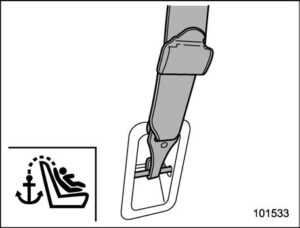
- . Latch the top tether hook onto the tether anchorage that is located behind the rear seat and tighten the top tether firmly.
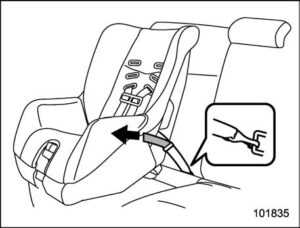
- To remove the child restraint system, press the release button on the seat-belt buckle and allow the belt to retract completely. The belt will return to the ELR mode.
press the release button on the seatbelt buckle and allow the belt to retract completely. The belt will return to the ELR mode. Remember that the head restraint is not intended to be used at the lowest position (retracted position). Therefore, when the rear center seat is occupied (including when a child restraint system is installed) next time, be sure to raise the head restraint to the extended position.
NOTE
When the child restraint system is no longer in use, remove it and restore the ELR function of the retractor. That function is restored by allowing the seatbelt to retract fully.
Installing a booster seat or booster cushion
- Adjust the head restraint as follows.
For booster seat:

- Remove the head restraint from the rear seating position where the child restraint system is to be installed.
- Store the removed head restraint in the cargo area.
CAUTION
Do not place the head restraint in the passenger compartment to prevent it from being thrown around in the passenger compartment in a sudden stop or a sharp turn.
For booster cushion:
- Raise the head restraint to the extended position (center seat). Do not remove the head restraint.
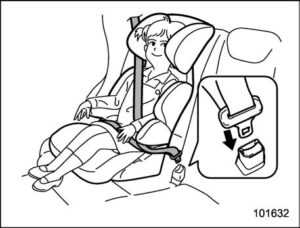
- Place the booster seat/cushion in the rear seating position and sit the child on it. The child should sit well back on the booster seat/cushion.
- For models with rear seat reclining mechanism, if there is a gap between the booster seat/cushion and the seat-back, adjust the seatback angle until good contact is achieved.
- Run the lap and shoulder belt through or around the booster seat/cushion and the child following the instructions provided by its manufacturer. For booster seat/cushion with a belt guide, use the seatbelt through the belt guide.
- Insert the tongue plate into the buckle until you hear a click. Take care not to twist the seatbelt.
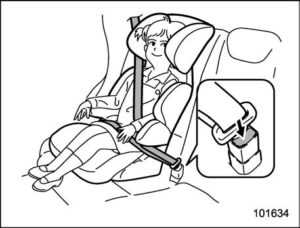 Make sure the shoulder belt is positioned across the center of child’s shoulder and that the lap belt is positioned as low as possible on the child’s hips.
Make sure the shoulder belt is positioned across the center of child’s shoulder and that the lap belt is positioned as low as possible on the child’s hips. - To remove the booster seat/cushion, press the release button on the seat-belt buckle and allow the belt to retract.
WARNING
- Never use a belt that is twisted or reversed. In an accident, this can increase the risk or severity of injury to the child.
- Never place the shoulder belt under the child’s arm or behind the child’s back. If an accident occurs, this can increase the risk or severity of injury to the child.
- The seatbelt should fit snugly in order to provide full restraint. Loose-fitting belts are not as effective in preventing or reducing injury.
- Place the lap belt as low as possible on the child’s hips. A high-positioned lap belt will increase the risk of sliding under the lap belt and of the lap belt sliding up over the abdomen, and both can result in serious injury or death.
- Make sure the shoulder belt is positioned across the center of the child’s shoulder. Placing the shoulder belt over the neck may result in neck injury during sudden braking or in a collision.
Installation of child restraint systems by use of lower and tether anchorages (LATCH)
Lower and tether anchorages
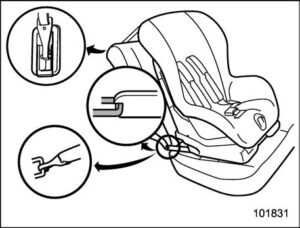
WARNING
- Attach the child restraint system to the anchors properly. When using the LATCH anchors, be sure that there are no foreign objects around the anchors. Make sure the child restraint system is securely attached. Otherwise, it may cause death or serious injury to children or other passengers in sudden braking, swerving, or accidents.
- When installing a child restraint system using LATCH anchors with the rear seatbelt fastened, ensure that the rear seatbelt does not become caught in the child restraint system or the lower LATCH anchorages.
NOTE
The seatbelt warning system of the rear seats detects if any of the seats are occupied by a passenger. Installing a child restraint system in the rear seating area, using the LATCH anchors, may result in the activation of the passenger seatbelt warning light and chime. Fastening the rear seatbelt prior to installing the child restraint system will avoid activating the passenger seatbelt warning light and chime.
Some types of child restraint systems can be installed on the rear seat of your vehicle without use of the seatbelts. Such child restraint systems are secured to the dedicated anchorages provided on the vehicle body. The lower and tether anchorages are sometimes referred to as the LATCH system (Lower Anchors and Tethers for CHildren).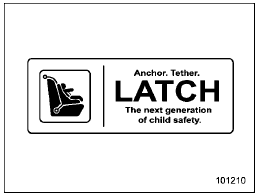
Your vehicle is equipped with five lower anchorages (bars) and three upper anchorages (tether anchorages) for accommodating such child restraint systems.
Lower anchorages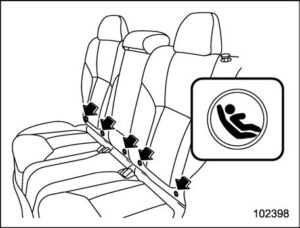
WARNING
Do not connect two or lower hooks onto the same anchorage (bar).
There are a total of 5 lower anchorages at the rear seat. The second lower ancho-rage from the right side is used for both the right seat and center seat. Each lower anchorage is located where the seat cushion meets the seatback.
Tether anchorages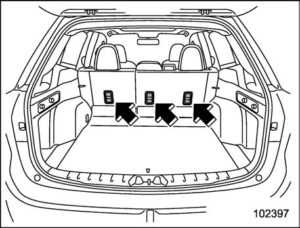
The tether anchorages (upper anchorages) are provided at the locations shown in the above illustration.
To install a child restraint system using lower and tether anchorages
WARNING
Before installing a child restraint system, be sure to confirm that the seatback is securely locked into place. Otherwise, in an accident, serious injury or death could result.
- Move the seatback back and forth to confirm that it is securely locked into place.
Check the red colored unlocking marker which is attached to the bottom of the lock release knob is not visible.

- You will find “ ” marks at the bottoms of the rear seatback. These marks indicate the positions of the lower anchorages (bars).
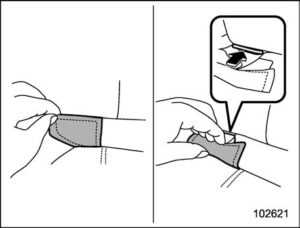
- Peel off the anchorage cover from the selected side of the rear seatback. Fold the peeled anchorage cover in half and affix it with hook and loop tape to expose the anchorages (bars) to be used for installation of the child restraint system.
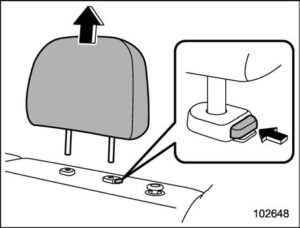
- Remove the rear seat head restraint.
CAUTION
Store the head restraint in the cargo area. Do not place the head restraint in the passenger compartment to prevent it from being thrown around in the passenger compartment in a sudden stop or a sharp turn.

- While following the instructions sup-plied by the child restraint system manufacturer, connect the lower hooks onto the lower anchorages located at “ ” marks on the bottom of the rear seatback. When the hooks are connected, make sure the adjacent seat-belts are not caught.
- For models with rear seat reclining mechanism, if there is a gap between the child restraint system and the seatback, adjust the seatback angle until good contact is achieved.
- If your child restraint system is a flexible attachment type (which uses tether belts), push the child restraint system into the seat cushion and pull both left and right lower tether belts up to secure the child restraint system by taking up the slack in the belt.
- Latch the top tether hook onto the tether anchorage that is located behind the rear seat and tighten the top tether firmly.

- Before having a child sit in the child restraint system, try to move it back and forth and right and left to check if it is firmly secured. Sometimes a child restraint system can be more firmly secured by pushing it down into the seat cushion. It should not be possible to move the child restraint system more than 1 in (2.5 cm).
- To remove the child restraint system, follow the reverse procedures of installation.
SUBARU recommends that you check with a certified Child Passenger Safety Technician to ensure the proper installation of your child restraint system. For more information, and to locate the closest inspection location in the U.S., refer to the National Highway Traffic Safety Administration (NHTSA) website. In Canada, check with Transport Canada.
Top tether anchorages
Your vehicle is equipped with three top tether anchorages so that a child restraint system having a top tether can be installed in the rear seat. When installing a child restraint system using top tether, proceed as follows, while observing the instructions by the child restraint system manufacturer.
Since a top tether can provide additional stability by offering another connection between a child restraint system and the vehicle, we recommend that you use a top tether whenever one is required or available.
Anchorage location
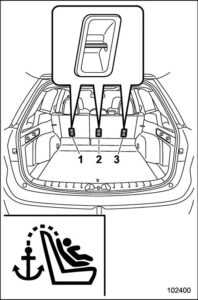
- For left seat
- For center seat
- For right seat
Three upper anchorages are installed on the back side of the rear seatback.
To hook the top tether
CAUTION
- Remove the head restraint when mounting a child restraint system. Otherwise, the top tether cannot be fastened tightly.
- Store the head restraint that has been removed in the cargo area. Do not place the head restraint in the passenger compartment to prevent it from being thrown around in the passenger compartment in a sudden stop or a sharp turn.

- Attach the top tether hook to the appropriate upper anchorage.
- Tighten the top tether securely.
SUBARU recommends that you check with a certified Child Passenger Safety Technician to ensure the proper installation of your child restraint system. For more information, and to locate the closest inspection location in the U.S., refer to the National Highway Traffic Safety Administration (NHTSA) website. In Canada, check with Transport Canada.
FAQ
What is the purpose of seatbelt pretensioners in the 2023 Subaru Forester?
Seatbelt pretensioners automatically tighten the seatbelts during a collision to reduce slack and enhance passenger restraint.
How do seatbelt pretensioners work in the Forester?
In the event of a collision, seatbelt pretensioners use pyrotechnic devices to retract and tighten the seatbelts across the occupants’ chests.
Are seatbelt pretensioners available for all seats in the Forester?
Seatbelt pretensioners are typically available for the front seats of the Forester, where they are most critical for safety.
Do seatbelt pretensioners also function during rollover incidents?
Seatbelt pretensioners may activate during rollover incidents or severe impacts to help keep passengers securely restrained.
Are seatbelt pretensioners reusable after deployment?
No, seatbelt pretensioners are one-time-use devices, and they should be replaced after deployment.
What is the purpose of the child restraint system in the 2023 Forester?
The child restraint system provides a secure and designated anchoring point for installing child safety seats, ensuring the safety of young passengers.
Is the child restraint system compatible with various types of child safety seats?
Yes, the child restraint system is designed to accommodate different types of child safety seats, including rear-facing and forward-facing seats.
Does the Forester come equipped with the LATCH (Lower Anchors and Tethers for Children) system for child safety seats?
Yes, the Forester typically includes the LATCH system, making it easier to secure child safety seats.
Can child safety seats be installed in both the rear and front seats of the Forester?
Child safety seats should be installed in the rear seats of the Forester, as it is generally safer for children to ride in the rear.
Are there specific weight or age recommendations for using child safety seats in the Forester?
Yes, the owner’s manual typically provides guidelines for the appropriate weight and age range for child safety seat usage.
Is there a maximum number of child safety seats that can be installed in the Forester?
The Forester’s seating configuration and the size of child safety seats may impact the number that can be installed, but it is recommended to follow safety guidelines.
Are there any additional safety features related to child passenger safety in the 2023 Forester?
The Forester may include additional safety features like rear-door child locks and seatbelt reminders to enhance child passenger safety.
Can I get assistance or guidance on properly installing child safety seats in the Forester?
Subaru dealerships and certified technicians can provide guidance and assistance with the correct installation of child safety seats.
Are there any state-specific regulations regarding child safety seat usage in the Forester?
Child safety seat regulations can vary by state, so it’s important to check your local laws and regulations for compliance.
How can I find more information about seatbelt pretensioners and child restraint features in the 2023 Forester?
You can refer to the owner’s manual, contact a Subaru dealership, or visit the Subaru website for detailed information about these safety features and their operation in the 2023 Forester.
Useful Link
View Full User Guide: Subaru Forester 2023 Base User Guide
Download Manuals: https://www.subaru.com/owners/vehicle-resources/manuals.html
2023 Subaru Forester Specs, Price, Features, Mileage (Brochure)

